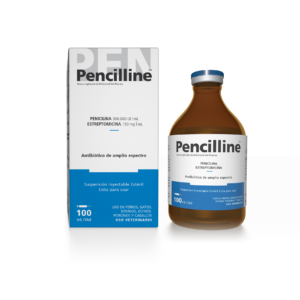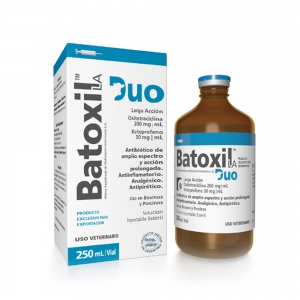AMPILINE
Registered Trademark of Richmond Veterinary Division S.A.
Sodium Ampicillin
Ampiline. Broad-spectrum bactericidal antibiotic. Injectable sodium ampicillin 6.0 g per vial of reconstitutable sterile lyophilized powder
Composition
Each vial with powder contains: Sodium ampicillin 6 g.
Each vial with diluent contains: Water for injection q.s. 20 ml.
Indications of Use
Ampicillin is a semi-synthetic derivative of penicillin, differing from it by its broad spectrum, bactericidal action with great antibacterial capacity and greater activity on bacteria resistant to beta-lactams.
Ampiline is effective against Gram+ and Gram- bacteria, including the genera: Corynebacterium, Listeria Monocytogenes, Pasteurella Multocida, Streptococcus, Staphilococcus and Haemophilus infeluenzae, analog bacteria such as Fusobacterium, Peptococcus, as well as certain types of Bacteroides and Clostridium; Spirochaetas; including Leptospira and Borrelia sp. Enterobacteria such as E. Coli, Proteus mirabilis, Klebsiella and Salmonella are also susceptible to ampicillin.
Ampiline is indicated in infections of the: upper and lower respiratory system (tonsillitis, bronchopneumonia, pleurisy), urinary tract and reproductive system, gastrointestinal and dermal infections (dermatitis, pustules, abscesses, cellulitis, and infections of the perianal gland), mastitis, cavity infections such as septic peritonitis, metritis, arthritis and soft tissue infections in general. Antibiotic of choice in pre and post surgical prevention.
Ampiline is an antibiotic recommended for use in cattle, sport horses, sheep, pigs, canines and cats of all breeds, sex, ages and productive conditions.
Reconstitution of the product
Transfer by needle and hypodermic syringe and under sterile conditions, the diluent from the vial to the vial containing the powder. Shake until the powder is completely dissolved, obtaining a translucent, amber solution. Wait a few minutes until the possible foam formed by the agitation is eliminated, and under adequate aseptic and antiseptic conditions proceed to load the necessary dose. It is suggested that the ampoule corresponding to the diluent be warmed in a water bath to improve the reconstitution of the powder. The product should be reconstituted at the time of use. What is not used should be discarded.
Final concentration of reconstituted product: 300 mg/mL.
Collateral and secondary actions
Ampicillin is normally well tolerated at the described dose, routes and frequencies in non-allergic patients. Symptoms such as vomiting, dysbacterial diarrhea, itching, or localized reactions at the injection site may occasionally occur in sensitive animals. In these cases the medication with the antibiotic should be suspended and the corresponding symptomatic treatment should be carried out.
Routes of administration
Subcutaneous, Intramuscular and Intravenous.
Suggestions
In neonatal animals, the use of the intravenous route is recommended, due to the lack of maturity of the peripheral circulation.
In case of intravenous administration in bolus, the total injection of the calculated dose should be done in a time not less than 3 minutes.
For preventive use in surgical interventions, it should be administered prior to anesthetic induction, suspending treatment 24 hours after the surgical maneuvers are completed.
In severe infections, it is suggested to implement during the first 24 hours a protocol with the lowest frequency of application suggested using the intravenous route, according to the species under the strict supervision of the veterinary doctor involved.
It is suggested that antibiotic therapy be performed for not less than 7 days of treatment according to the protocol of doses and frequencies selected for each particular case.
Synergism
Ampicillin may be combined with other bactericidal agents such as Gentamicin, Amikacin, Sulfa/Trimetropin, Chloramphenicol and Erythromycin.
Withdrawal period
Cattle: Do not use the meat or edible tissues of treated animals for human consumption or industrialization, during the time of treatment and until 144 hours (6 days) after the last treatment. 48 hours must pass after the end of the treatment (or the equivalent time to 4 subsequent milking), to destine the milk to the treated animals for human consumption and/or its industrialization.
Equines: Sporting horses only, not for human consumption.
Pigs: Do not use the meat or edible tissues for human consumption until 15 days after the last treatment.
Precautions and Warnings
Do not administer in patients with a history of sensitivity to penicillins. In case of shock due to hypersensitivity to the drug, epinephrine and hydrocortisone should be administered together with the corresponding symptomatic treatment. Do not combine with bacteriostatic agents.
Do not mix with alkaline substances, solutions containing carbohydrates or blood derivatives or protein hydrolysates.
Do not mix in the same bottle with aminoglycoside agents.
Do not ingest. Keep out of reach of children and pets.
Store the product without reconstitution between 15 and 30 ºC, away from sunlight, in a dry and hygienic place.
Suggested doses and warnings are for the consideration of the attending veterinarian.
TABLE OF INDICATIVE DOSAGE
Species Dose Route* Frequency
Horses 3.0 to 10.0 mg/kg IV/IM Every 8 to 12 hours
Cattle and Sheep 10.0 to 20.0 mg/kg SC/IM/IV Every 12 hs.
Pigs 6.0 to 8, mg/kg SC/IM Every 8 to 12 hs.
Dogs and Cats 5.0 to 10.0 mg/kg IV/SC Every 6 to 8 hs.
(*) Corresponds to the reconstituted product. References: Intravenous IV, intramuscular IM, subcutaneous SC
Ampiline Large. Case containing 6 vials with 6.0 g of ampicillin sodium injection sterile lyophilized powder, with 6 vials of water for injection to reconstitute containing 20 ml.
Related products
Attention schedule:
Mon a Fri: 08:00-17:00
Where we are
Mail:
Fragata Heroína 4988 (B1615ICH)
Grand Bourg, Buenos Aires, Argentina.
Contact
Phone:
0810-333-7424
Correo electrónico:
info@richmondvet.com.ar







